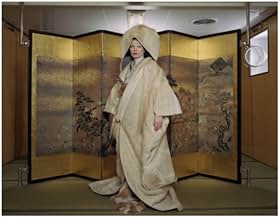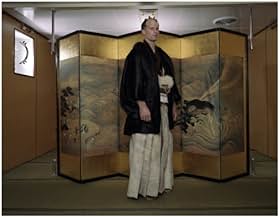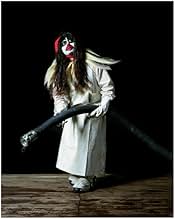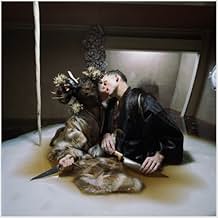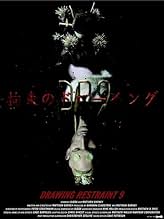NOTE IMDb
6,5/10
1,6 k
MA NOTE
Ajouter une intrigue dans votre langueThe film concerns the theme of self-imposed limitation and continues Matthew Barney's interest in religious rite, this time focusing on Shinto.The film concerns the theme of self-imposed limitation and continues Matthew Barney's interest in religious rite, this time focusing on Shinto.The film concerns the theme of self-imposed limitation and continues Matthew Barney's interest in religious rite, this time focusing on Shinto.
- Récompenses
- 1 nomination au total
Avis à la une
To hear Matthew Barney interviewed, saying things like "I will continue to manipulate space in film," you would think that he has nothing on his mind but process. Yet the evolution of Drawing Restraint 9 is spiritual, not formal. DR9, in fact, is a complete repudiation of the noxious Ayn Rand-stinking cosmology of the Cremaster films. Freud has been replaced by Jung, and Hegel by Kierkegaard. This is a Barney film that could bring you to tears. Any doubts about whether he's an artist or fraud are laid to rest by this film -- frauds do not grow, they just keep along the same path.
I had my doubts about the Cremaster films ( except for Cremaster 2, still the most uncanny piece on Barney's resume ) The first hour and a half of Drawing Restraint 9 had me squirming, sure that Barney was unmasking himself as a joke once and for all. All of Barney's faults are on display -- the crude appropriation and dim understanding of other cultures and myths, the glossy yet flat cinematography that would only look stylish to a reader of Vogue, the hunch that the only movie he's ever seen is The Shining, and a generally unfocused feeling, as if he's casting around for meaning that isn't there. And then, of course, there are those endless shots of men doing their work, building a better future, creating that obelisk to the sky! Except here the bumbleheaded Hegelian philosophy of history-in-action was even more boring because of the documentary trappings. Instead of showing a legless woman strap on a blade and chop potatoes, a metaphor for a half-completed action, we see real men doing real jobs. Only occasionally Barney has them producing one of his symbols, or sticks a blue feathered afro on top of a tanker, so that we know these seemingly mundane tasks will eventually have vaguely triumphant, Wagnerian results.
Then, suddenly -- if you can speak of suddenness in a film like this, and I think you can -- the Japanese men start loading a harpoon gun and firing nasty spikes at nasty speeds into the sea. And you realize that what you took to be another Barney paean to progress has crumbled. We are now sailing in deep hippie waters, my friend. And the sailing is good. Barney and Bjork retire to a tatami-matted cabin and the film begins to go places the Cremaster films would never dare. The cinematographer suddenly discovers shadow and grain-texture. Bjork's uninspired score becomes hypnotic. A feeling of death, doubt, and failure creeps into the film, as a Japanese sage tells a story of a primal scar made by the collision of two ships, while Barney and Bjork are posed with the edge of a whale statue separating them. The personal, the political, the spiritual and the mythical start to engage in supercollision.
The film seems to have been conceived as an exercise in humility, repentance for the colossal egotism of the Cremaster films. Barney takes pains to highlight his new bald spot, making him look like a tonsured monk, there is a nude scene which proves he is no Vincent Gallo, and -- most memorably -- Barney speaks! As a studly silent mannequin in the Cremaster films, he had mystery, but here he lets you in on the dirty little secret: He has the geekiest voice in history, almost like how a castrato would talk in daily conversation. Listen closer, however, and he sounds almost angelic...
This new humility, which may have roots in marriage troubles or encroaching baldness -- the root of insight is often just this shallow -- justifies the Asiatic trappings. But Barney is hiding his real light under a bushel. It is a Western religion that truly moves him these days. There are a "trinity" ( hint hint ) of symbols consisting of whale ambergris, pomegranate seeds and shrimp whose meaning I won't spoil for you. Except to say that Barney is calling you a shrimp. And asking you to be a whale. The "restraint" of the title starts to feel a whole lot more like renunciation, and the inner joys it brings.
Life is fair after all: It costs ten dollars for a ticket to DR9, and unless you're a zombie, you will get more pleasure and consolation from this film than any billionaire computer-peddler could get out of one of Barney's vaseline tubs.
I had my doubts about the Cremaster films ( except for Cremaster 2, still the most uncanny piece on Barney's resume ) The first hour and a half of Drawing Restraint 9 had me squirming, sure that Barney was unmasking himself as a joke once and for all. All of Barney's faults are on display -- the crude appropriation and dim understanding of other cultures and myths, the glossy yet flat cinematography that would only look stylish to a reader of Vogue, the hunch that the only movie he's ever seen is The Shining, and a generally unfocused feeling, as if he's casting around for meaning that isn't there. And then, of course, there are those endless shots of men doing their work, building a better future, creating that obelisk to the sky! Except here the bumbleheaded Hegelian philosophy of history-in-action was even more boring because of the documentary trappings. Instead of showing a legless woman strap on a blade and chop potatoes, a metaphor for a half-completed action, we see real men doing real jobs. Only occasionally Barney has them producing one of his symbols, or sticks a blue feathered afro on top of a tanker, so that we know these seemingly mundane tasks will eventually have vaguely triumphant, Wagnerian results.
Then, suddenly -- if you can speak of suddenness in a film like this, and I think you can -- the Japanese men start loading a harpoon gun and firing nasty spikes at nasty speeds into the sea. And you realize that what you took to be another Barney paean to progress has crumbled. We are now sailing in deep hippie waters, my friend. And the sailing is good. Barney and Bjork retire to a tatami-matted cabin and the film begins to go places the Cremaster films would never dare. The cinematographer suddenly discovers shadow and grain-texture. Bjork's uninspired score becomes hypnotic. A feeling of death, doubt, and failure creeps into the film, as a Japanese sage tells a story of a primal scar made by the collision of two ships, while Barney and Bjork are posed with the edge of a whale statue separating them. The personal, the political, the spiritual and the mythical start to engage in supercollision.
The film seems to have been conceived as an exercise in humility, repentance for the colossal egotism of the Cremaster films. Barney takes pains to highlight his new bald spot, making him look like a tonsured monk, there is a nude scene which proves he is no Vincent Gallo, and -- most memorably -- Barney speaks! As a studly silent mannequin in the Cremaster films, he had mystery, but here he lets you in on the dirty little secret: He has the geekiest voice in history, almost like how a castrato would talk in daily conversation. Listen closer, however, and he sounds almost angelic...
This new humility, which may have roots in marriage troubles or encroaching baldness -- the root of insight is often just this shallow -- justifies the Asiatic trappings. But Barney is hiding his real light under a bushel. It is a Western religion that truly moves him these days. There are a "trinity" ( hint hint ) of symbols consisting of whale ambergris, pomegranate seeds and shrimp whose meaning I won't spoil for you. Except to say that Barney is calling you a shrimp. And asking you to be a whale. The "restraint" of the title starts to feel a whole lot more like renunciation, and the inner joys it brings.
Life is fair after all: It costs ten dollars for a ticket to DR9, and unless you're a zombie, you will get more pleasure and consolation from this film than any billionaire computer-peddler could get out of one of Barney's vaseline tubs.
There's no dialogue for a while, and then there's some Japanese dialogue, and all the while, I didn't really know what was going on. I was lost at pretty much all times, but that was to be expected. This had "avant-garde" written all over it, and for being an art piece, I guess it's sporadically interesting. It probably achieves what it sets out to do, but whatever that is feels unclear to me. If you want to dive in, there's probably a lot to chew on, but as to whether it would taste any good, who knows. Probably not. But it's challenging. That's more of an observation rather than something that makes it bad or good. And there's some music here composed by Bjork, though she didn't do all the music it seems. I don't know.
That's my take away. I don't know.
That's my take away. I don't know.
DR9 shouldn't really be thought of as a film in the traditional sense of the word, nor should it sit alone, its part of a greater work of art, the clue is in the title! To really appreciate the film it helps to see it in relation to sculpture and the way objects interact within a chosen space. also the resonance of ritual and especially Japanese shinto can bring a certain amount of meaning and clarity to some of the more obscure sequences in the film. even though it seems very 'serious and arty' on the surface ,there is humour and romance and the film! try not to see it as a finite static thing, but something that can change according to the multiple layers you allow yourself to perceive it on.
I originally saw this at it's Toronto Film Festival premiere. I went alone and allowed myself to be drawn in slowly, almost becoming hypnotized by it. The film is like a long, bizarre, beautiful dream that made me feel like I was high on some wonderful drug.
The imagery is stunning, inspired! Bjork's soundtrack is perfect. Both Barney and Bjork provide compelling performances. What more can be said except see this film and let it speak to you. Its a wonderful opportunity to see some experimental film by a truly gifted artist (or pair of artists, including Bjork's significant contributions)
Take a chance, it'll be worth it.
The imagery is stunning, inspired! Bjork's soundtrack is perfect. Both Barney and Bjork provide compelling performances. What more can be said except see this film and let it speak to you. Its a wonderful opportunity to see some experimental film by a truly gifted artist (or pair of artists, including Bjork's significant contributions)
Take a chance, it'll be worth it.
I just saw this the other day. I Was in the second row of the cinema so close to all these weird happenings. I knew that it would be slow and hardly without a story. With that in mind I really liked the slow moving pictures, the building of the big Vaseline-sculpture, and the meeting between Björk and Barney(it takes a long time before they actually meet on screen)
I see why some people would find it annoying, but to me it had some stunning visuals and the music was really good.
Just sit back and relax and don't expect much more than two hours of slow moving and weird stuff.
I see why some people would find it annoying, but to me it had some stunning visuals and the music was really good.
Just sit back and relax and don't expect much more than two hours of slow moving and weird stuff.
Le saviez-vous
- Bandes originalesGratitude
Written by Björk and Matthew Barney
Vocal by Will Oldham
Harp played by Zeena Parkins
Celeste played by Jónas Sen
Keyboard played by Nico Muhly
Arranging & editing by Björk
Programming by Björk and Valgeir Sigurðsson
Produced by Björk
Meilleurs choix
Connectez-vous pour évaluer et suivre la liste de favoris afin de recevoir des recommandations personnalisées
- How long is Drawing Restraint 9?Alimenté par Alexa
Détails
Box-office
- Montant brut aux États-Unis et au Canada
- 234 743 $US
- Week-end de sortie aux États-Unis et au Canada
- 18 011 $US
- 2 avr. 2006
- Montant brut mondial
- 267 275 $US
- Durée2 heures 15 minutes
- Couleur
- Mixage
- Rapport de forme
- 1.85 : 1
Contribuer à cette page
Suggérer une modification ou ajouter du contenu manquant

Lacune principale
By what name was Drawing Restraint 9 (2005) officially released in Canada in English?
Répondre

